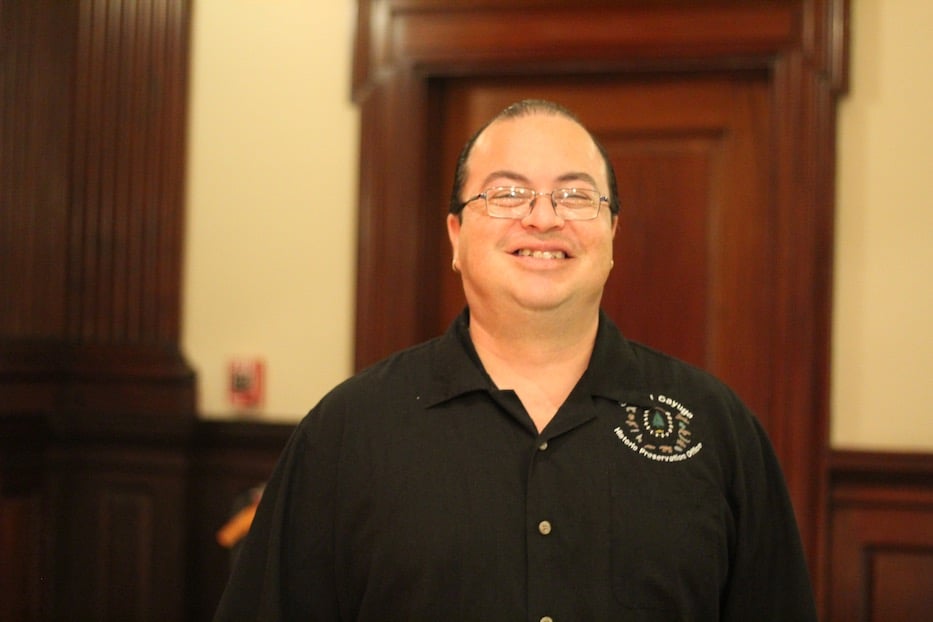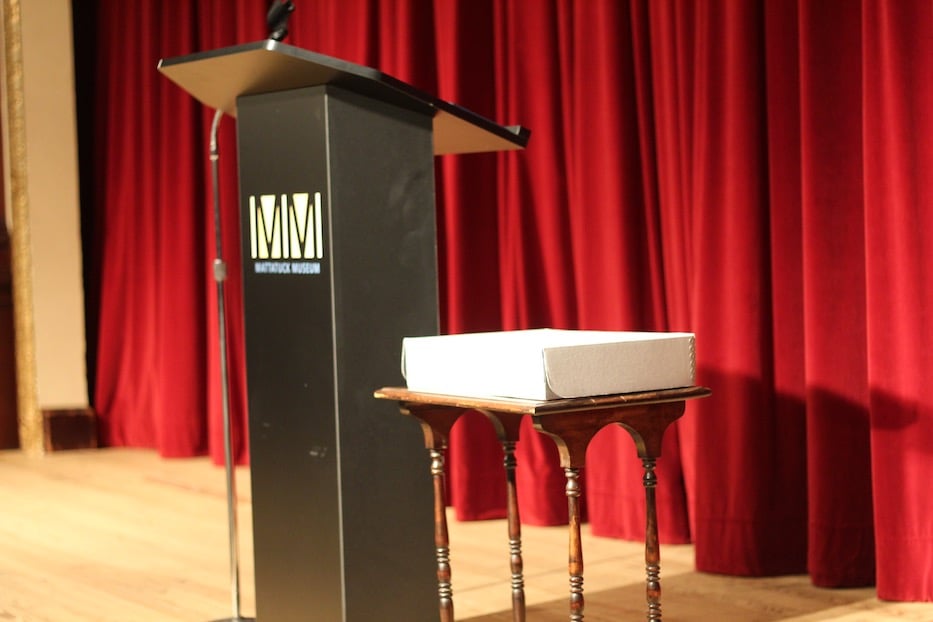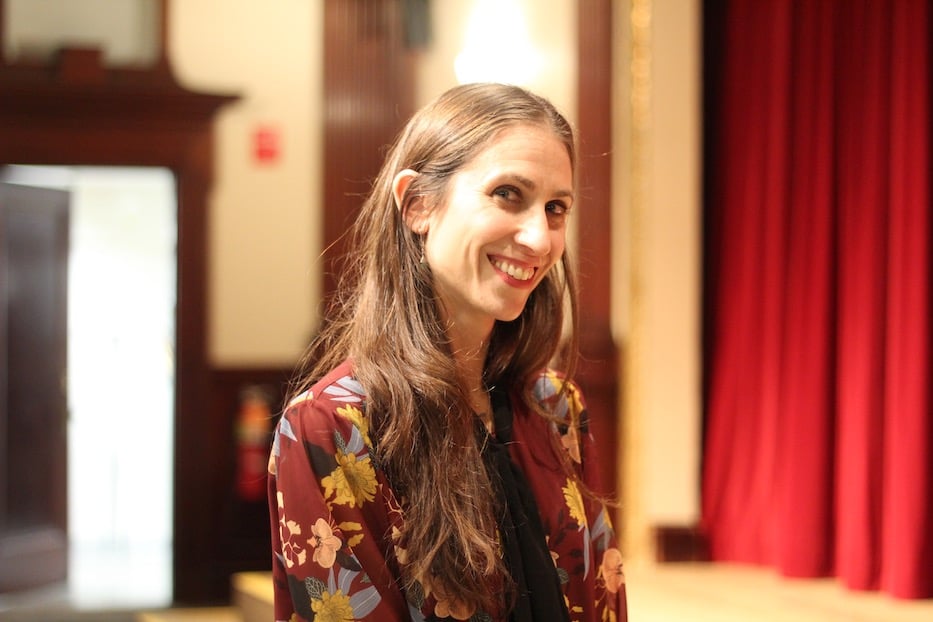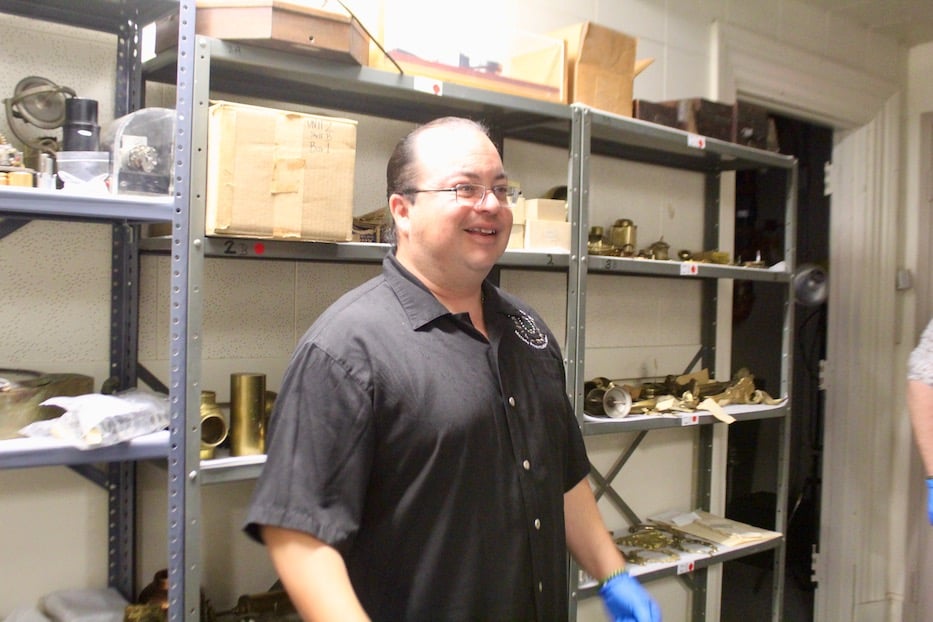
William Tarrant, a faith keeper and cultural preservation director of the Seneca-Cayuga Nation of Oklahoma, on Friday morning. Lucy Gellman Photos.
Waterbury's Mattatuck Museum can’t say under which circumstances a turtle shell rattle came into its collection in 1967. After 55 years, it is returning to its rightful owners, the Seneca-Cayuga Nation of Oklahoma.
Mattatuck staff made that announcement Friday morning, in a short repatriation ceremony at the museum with William Tarrant, a faith keeper and cultural preservation director of the Seneca-Cayuga Nation of Oklahoma, Mattatuck Chief Curator Cecelia “Keffie” Feldman, and Museum Director Bob Burns.
The repatriation of the rattle, which for over five decades lived in object storage, is in compliance with the Native American Graves and Repatriation Act, or NAGPRA.
It marks the first time the museum, founded in 1877, has repatriated a Native object. It is not the first time that the museum has acknowledged that it sits on stolen land: what people now recognize as Waterbury was for centuries shepherded by the Tunxis, Paugussett, Pequannock, and Potatuck tribal nations.
“It feels good,” said Tarrant, who is a member of the Seneca-Cayuga Deer Clan and also serves as the historic preservation director at NAGPRA. “I think it’s a healing thing. It excites me every time I get to bring something home.”
The rattle, which Tarrant said is over a century old, comprises the shell of an alligator snapping turtle that is about eight inches in diameter and attached to a wooden handle that leads to the turtle’s head. At the base, red and green thread tassels hang over the head, making it hard to see. On the underside of the rattle, text reads “Senecas Turkey Ford Okla. Mary Logan.” Over 100 years ago, Tarrant said, Logan was also ceremonial leader for the tribe.

The box in which the rattle was kept and exchanged during Friday's ceremony. Because it is a ceremonial object, it cannot be photographed.
The animal—its Cayuga name is Ganyáhdę—is particularly significant in the Seneca-Cayuga creation story; it is a symbol of both the earth and of the Turtle Clan. An official notice of intent to repatriate the object was submitted to the National Parks Service in July of this year.
"We are one of the only tribes in the area that still have our original religion, our ceremonial calendar, so this item will be able to be present," Tarrant said Friday.
The story of how or why it came into the museum’s collection is not well known, Feldman said. From its accession number, staff are certain that it entered the museum in 1967, but have minimal documentation beyond the object itself. The rattle has never been exhibited; for decades, it sat in on-site object storage.
And then when the museum began renovations in November 2018, curators embarked on an updated inventory of the collection to receive reaccreditation from the American Alliance of Museums (AAM). Part of that process entails being NAGPRA compliant, Feldman explained. Curators discovered that several objects in the collection fell into that category, including the rattle.
Feldman praised Assistant Curator Natalie DeQuarto for her role in researching objects and ensuring compliance. Of multiple tribes that the museum reached out to, she said, only Tarrant and the Seneca-Cayuga Nation have replied.

Chief Curator Cecelia “Keffie” Feldman.
"While we cannot undo the sometimes unjust past of museum collecting practices, returning this belonging to its community is a step towards righting the wrongs perpetrated toward Native peoples,” Feldman said Friday.
For Tarrant, who grew up in museums and has participated in ten such repatriations since taking his position in 2016, the moment marks a homecoming that is long overdue, and honors those who have come before him. Centuries ago, members of the Seneca-Cayuga Nation were in what is now recognized as New York and Canada, then migrated to Ohio before the American Revolution.
After 100 years in Ohio, the "Andrew Jackson Travel Agency"—that's Tarrant's shorthand for the Indian Removal Act of 1830—forced their relocation to Oklahoma. That means someone, or multiple someones, may have carried the rattle with them as they made the painful journey, Tarrant said.
Since, it has survived generations of trauma and theft—of land, of resources, of cultural customs. From 1872 to 1980 in Wyandotte, Oklahoma, Quakers founded and ran the Seneca Indian School, which took generations of children from their families and punished them physically for speaking Cayuga and other tribal languages.
Friday, Tarrant remembered how his grandmother—"one of the last generations to be rounded up by the government and taken to the schools"—would not allow fish in the house when he was a child, because the school’s punishment for speaking Cayuga was drinking fish oil. Sometimes, he added, administrators would also throw kerosine at and on the students.
It signaled the death of the Cayuga language, in which only ceremonial speeches and snippets of language remain.

Tarrant in object storage Friday morning after the ceremony.
"It was beat out of them so much," Tarrant said. And yet, he and others are constantly working to preserve and pass on culture. There is now a language teaching program out of Six Nations Polytechnic in Canada, as well as a Cayuga language teaching app in the Apple Play store. In the summers, he runs a Tribal Youth Summer Camp.
The rattle is part of that effort to mend and to heal, he said. He added that he bears no ill will toward the Mattatuck at this time—he doesn’t know if the rattle would have survived had the institution not been there to receive it.
"I don't know where the turtle would be if it wasn't for you guys [the Mattatuck]," he said. "We know it was separated from her [Mary Logan], but I would think that maybe she sold it to take care of her grandkids. So the turtle [rattle] might not exist if it hadn't been here for so long."
After inspecting the object Friday, Tarrant said that it will be returned to the False Face Medicine Society, for its use in False Face rituals. Because it is a ceremonial object, he asked that it not be photographed. Images of the object from the museum have also been taken down.
“I'm moved by this moment,” Burns said. “We are so grateful that we were able to repatriate this belonging.”